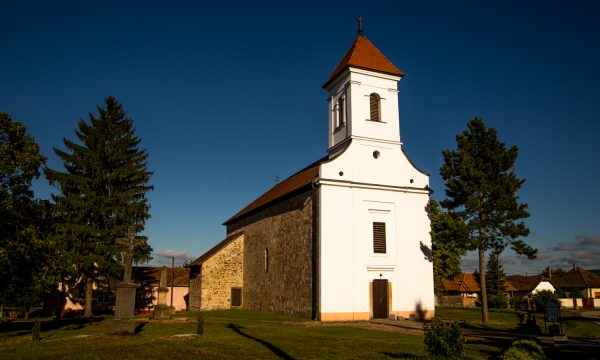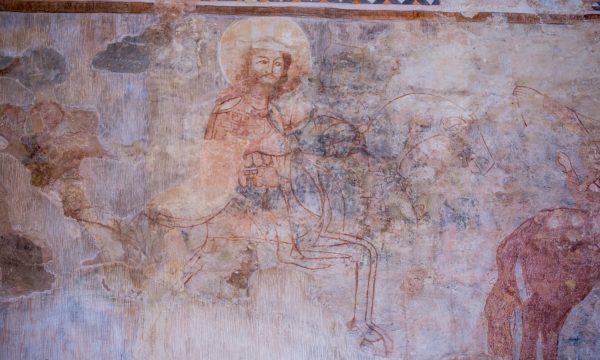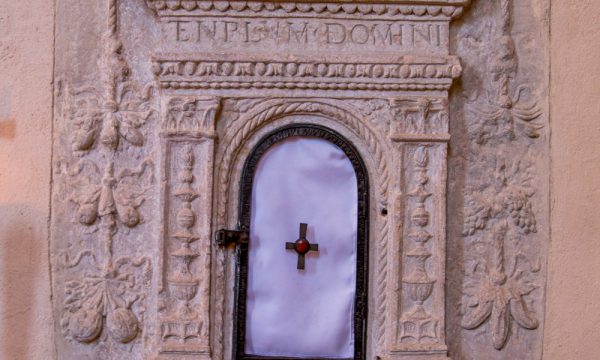Wall painting
Almost no archival sources have survived on the history of the former Benedictine abbey. However, it is certain that the monastery dedicated to the Holy Virgin, first mentioned in the Regestrum Varadinense, was already standing in 1219. During the monument’s restoration carried out between 1968 and 1971, five important construction phases were distinguished. In its first period, the building was probably a church with a single nave and a rectangular chancel, without a tower, built around the mid-12th century.

Its pair of western towers was probably built around the end of the 12th and the beginning of the 13th century, connected in an uncommon way to the nave’s northern, respectively southern walls. The monastery built to the church’s southern side must have also been completed in this period. The monastery had probably been gradually depopulating by the second half of the 15th century. We know from the letter addressed to the pope in 1485 by István Bajoni, canon of Vác and the commendator of the monastery, that the church, having been destroyed by fire, had collapsed.

Its radical reconstruction was probably carried out at the turn of the 16th century, during the time of István Bajomi. At this time its triumphal arch was moved, and the chancel received its present layout of equal width with the nave. This was probably the time when its subsequently demolished stellar vault was also built. In the northern wall of its chancel, a Renaissance tabernacle of high quality craftsmanship was built. Nevertheless, a decade later, King Vladislaus II wrote about the church as once again in decay, its monks abandoning it due to the great misery. Minor works have taken place around the mid-16th century, when its sacristy and a subsequent buttress were built. One of its Baroque altars was donated by Bishop Althan, while another by the Frideczky family. From its 18th century renovations, the ones from 1725 and 1788 were significant, as well as some of the ones carried out in the 19th century, i.e. the one started in 1847 and the one finished in 1896. Its present volume and spatial structure were shaped by the repair works that began in 1847. During this intervention, its medieval towers were demolished, and its present western façade with a single tower was finished by 1852.

Its mural paintings were discovered during the research and restoration works led by the National Inspectorate for Historic Monuments, with the support of abbot canon Frigyes Pálos. This was when the mediaeval details of the façade were also presented. Along with the female saints standing under a canopy, represented in the splay of the eastern window, the Saint Ladislaus cycle, discovered behind a covering wall dating from the modern period, is the largest valuable painted surface. The large painted register occupies more than half of the nave’s northern wall, running also under the triumphal arch. Its length is of 12.3 meters, its width of 2.5 meters. The part delimited by a frame with cosmatesque decoration is dated to the period of renewal, between 1330 and 1350. Unfortunately, its first scenes are faded and damaged. Nevertheless, it is possible to identify the scene of departure from Várad and the fragmented scene of battle. Unfortunately, there was a significant loss of painted surface between the former two, due to the opening of a new window. The chase scene is in a better state, divided by a tree with a stylized crown from the scenes of the wrestling and of the Cuman’s decapitation. Here, the frame surrounding the image is already decorated with a zigzag motif. The wrestling scene’s resting horses were tied to the tree acting almost as the composition’s axis. The last scene, that of the rest, is visible already behind the triumphal arch built at the turn of the 16th century, respectively beyond it, in the chancel.
Legend
Tereske is situated in the south-western part of Nógrád county and it is a beautiful Palóc village, with rich folk traditions. István Pál, the last Palóc bagpipe player lived here until his death in 2015. He was awarded the Népművészet Mestere (Master of Folk Arts) title, and his tales were published in different books. In the medieval church that stands in the centre of the settlement a Saint Ladislaus fresco cycle can be found, so far the only one in the Nógrád county. The fresco has a strong folk art character: in the middle of the painting we can see a tree that is sometimes interpreted as the mythical World Tree (világfa), a central element in the mythology of the Magyars prior to the conquest of the Carpathian basin. This mythical element can also be observed on the horses that are painted on top of each other – it can be interpreted as a shaman-fight. The kidnapped girl is also interesting – she wears a „csángó” type long shirt. These elements all suggest that the painter knew the folk version of the Saint Ladislaus legend. Another curious element is in the beheading scene: the cuman warrior is kneeling and praying before the king, begging for his life, and the girl is ready to strike him.
Mátraverebély-Szentkút is a town on the other side of the Cserhát Mountain, that was visited by the locals from Tereske at the main Virgin Mary feasts every year. The three springs have been known for centuries as miracle makers, the one linked to Saint Ladislaus is told to cure leg pain and pains related to the internal organs. According to a local legend, when the knight king was fighting the cumans and he had to flee, he jumped over a precipice and the mark of where his horse’s hoof landed can still be seen today. Furthermore, the spring named after Saint Ladislaus was formed in the spot where the king pierced his sword.
Natural heritage
Tereske village is located in the western part of Nógrád county, in the easternmost third of the Nógrád Basin. The woody vegetation in this hilly country is only a fragment of what it once was. In the remaining Austrian oak (Quercus cerris) and Hornbeam (Carpinus) forests one can still observe the Lilium martagon, the violet limodore (Limodorum abortivum), and several Cephalanthera species. At the bottom of the hills, fresh meadows and marshes lie. Unfortunately, with the disappearance of the native flora, new invasive plants have taken hold in the region, like the Ailanthus, boxelder maple (Acer negundo), and Amorpha fruticosa species.
On the eastern side of the village church, on 1.5 hectares lies the local graveyard, which became a protected area in 1977 in order to preserve the local cultural and natural values. In this old garden, which is a public graveyard, there are similarly old, lean trees. Among these trees a copper beech (Fagus sylvatica f. purpurea), a red leaved, ornamental version of the European beech, is most notable. Its pointed leaves are the shape of an upturned egg, their edges straight or slightly wavy. They are coloured dark-red, with light hairs in young age. Not far from these grow specimen of the midland hawthorn (Crataegus laevigata), the Norway spruce (Picea abies), the filbert (Corylus maxima), and the European beech (Fagus sylvatica). This latter tree, with its 3m circumference and 170 years of age, is one of the most cherished trees of the garden.
The old trees and the extensive shrubs are home to many birds. The common blackbird (Turdus merula) can often be seen looking for food on the ground beneath the bushes. The loud knocking of the woodpeckers (Picidae) can already be heard by the end of winter. The great spotted woodpecker (Dendrocopos major) breeds once a year, making its nest in the holes of dead or living trees. It eats mainly worms, ants, and bugs, but in the cold weather, it will eat fruits and other crops as well. The great tit (Parus major) and the Eurasian blue tit (Cyanistes caeruleus) are useful members of the garden’s flora, as they not only sing but also consume many of the leaf-eating caterpillars. The long-eared owl (Asio otus) also likes the groves of the old trees, and its characteristic voice and loud mating flight reveal its presence.
